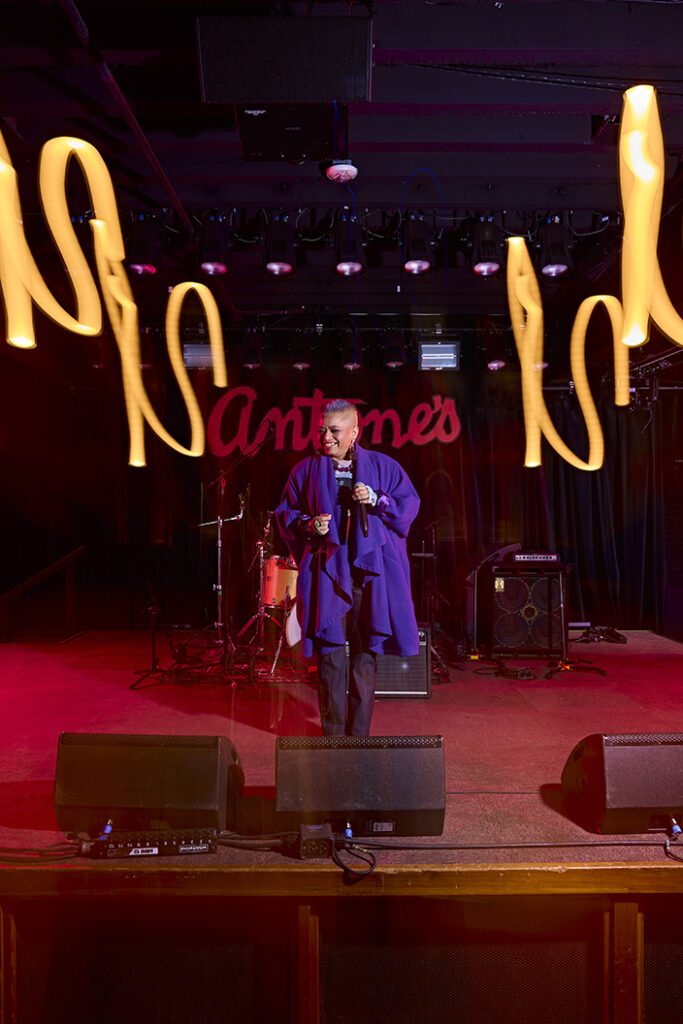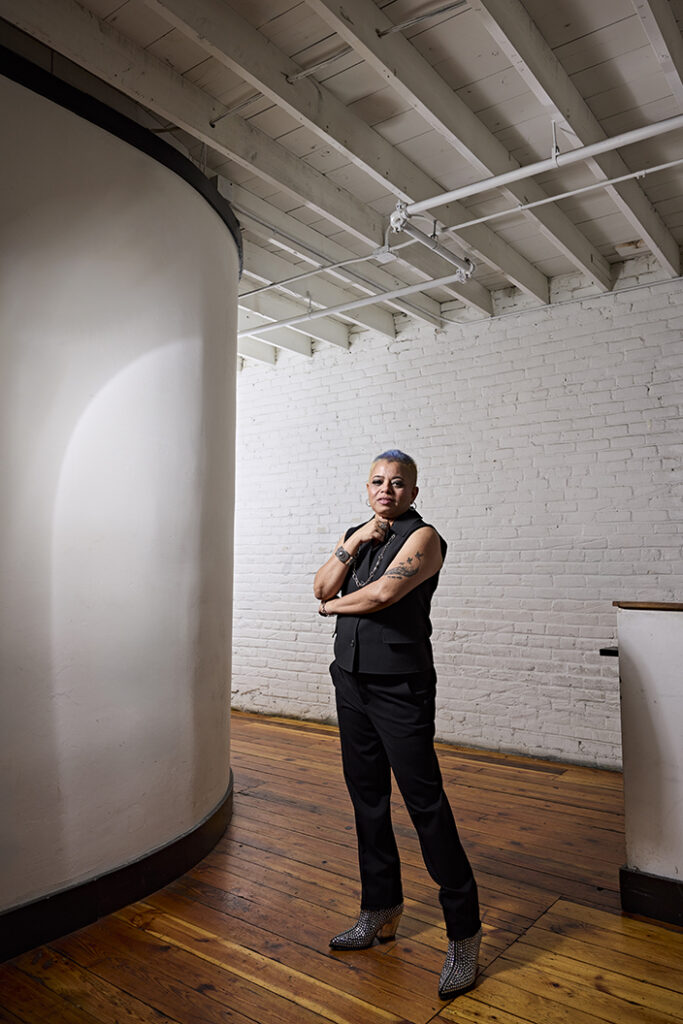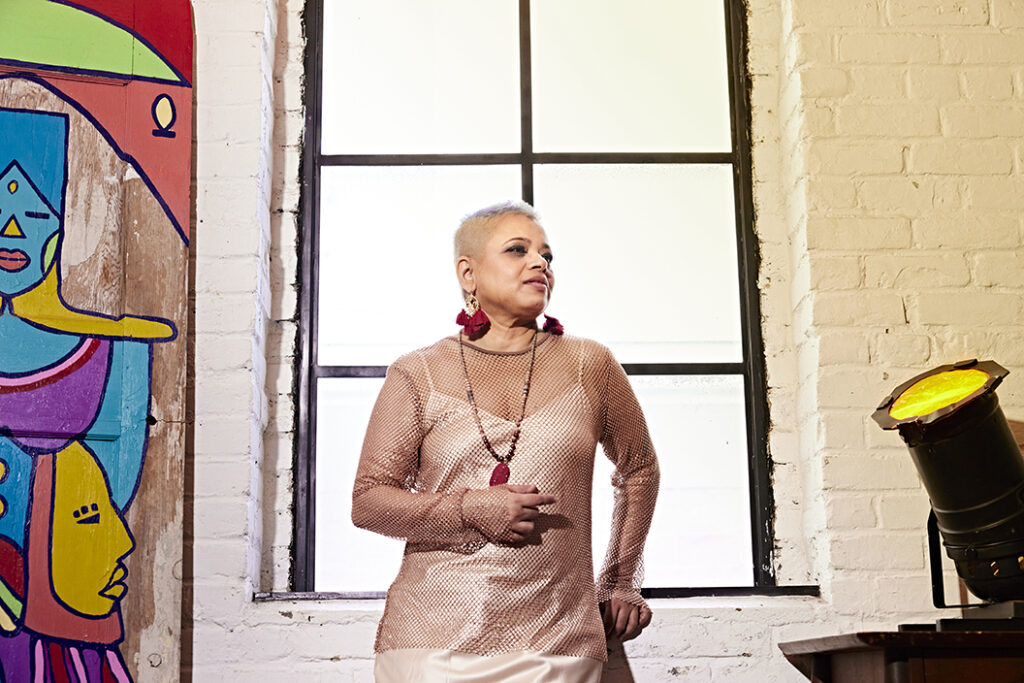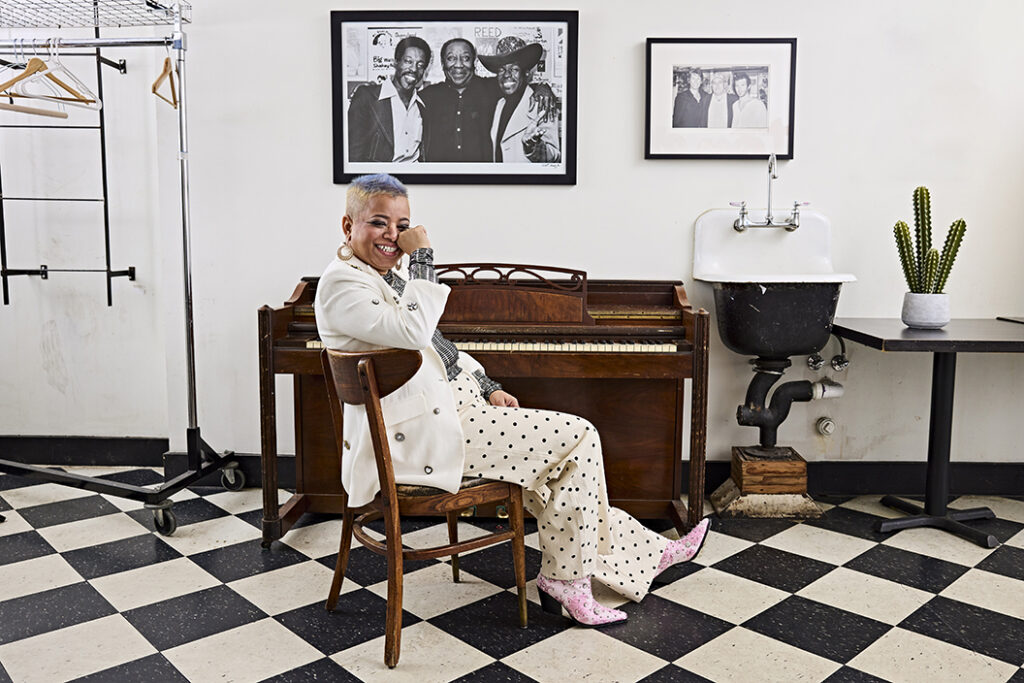Musician Nagavalli is on a journey of constant evolution.


By Cy White. Photos by Annie Ray. Styling by Parke Ballentine with inspiration from Impact Vintage (impactvintage.org, @impactvintageatx) and Nordstrom. Shot on location at Antone’s. Special thanks to Haley Caradine.
The menu is small and accommodating. After her photoshoot, she sits at a table at a formerly 24-hour diner (aptly called 24 Diner) that she knows serves a veggie burger. She talks about trying to go vegan as she peruses the menu options for the sides she wants. “But all of my favorite dishes have butter!” In this moment, as she chooses the mashed potatoes that are certainly full of butter, if the soft peak-whipped starch is anything to go by, she’s not only talking about having a “cheat day.” In this moment, Indian-American traditional-pop-soul fusion artist Nagavalli is talking about having grace. Being gracious with one’s self, being gracious with the efforts to get to the ultimate goal.
It makes sense, then, that so much of her life, her music, her artistry embodies the idea of graciousness. Being gracious for opportunities, having grace when some opportunities fall through. In fact, to hear her tell it, her entire life story is full of grace and a genuine feeling of graciousness.
Around the time Nagavalli was born and raised in Mumbai, India, the country had a population of between 9 million and 15 million, among them hundreds of thousands of children, all of whom were in one way or another absorbing spiritual lessons through song, dance, art or perhaps all three. Some, like Nagavalli, grew up surrounded by the sounds of traditional Indian classical music, learning the nuances, bends and melisma of the intricate singing style and bold citron hues of the compositions. It was through this artistic education from the age of 7 that Nagavalli first got her real taste of performance.
“When I was really young, I remember being in a classical dance class for a few months,” she says. “That was in first or second grade. My teacher got married and left town, and one of my class teachers told my mom, ‘Why don’t you get her into a music class?’ But I always had a bag for semi-classical light and more popular music. Anytime there was a popular, good record, whether it’s Bollywood or some independent artists, I remember very, very intensely always sitting and learning songs right off mostly cassette tapes and just obsessively learning a lot of songs from a very young age.
“I grew up learning Indian classical music, and, of course, a healthy amount of exposure to Bollywood music, or maybe unhealthy amount of exposure to Bollywood music,” she says with a chuckle in her voice. “So the amount of English pop or rock or soul records that I listened to was fairly limited. It was anything that was kind of popular when I was attending college in Mumbai. Everything from Elton John to Madonna, and then somebody introduced me to Guns N’ Roses; I was listening to Guns N’ Roses for a while. Tracy Chapman, though…” She pauses to revel a bit in a fond memory. “On a Grammy compilation probably in 1989, I believe is when she won for ‘Fast Car.’ That was the very first English cassette tape that I bought for myself. So I have very heartfelt memories about owning that cassette and how much I cherished that.”

The long hours, many days and weeks of practice certainly show themselves in the way she performs. Confidence, it radiates off her in waves. There’s a steadfast readiness, something like expectation of a great performance without having sung the first note. Calm, a relaxed knowing that all the energies combined in the room ensure this is going to be a night to remember for her and her captive audience.
Nagavalli is a giant on stage. Despite her near self-deprecating shyness when she has to pose for photos earlier in the week, her presence when she’s under the spotlight at Stateside at the Paramount Theatre, mic in hand, is a revelation. Regardless of the reverb, on Saturday, Feb. 10 when she debuts her “First and Foremost” show to a sold-out audience, her voice is steady as it carries beyond the seats, outside the theater, beyond South Congress Avenue and out into the universe, to be embraced by the very same thing that blessed her talent. She shines, her very own beacon among the spotlights, and those who join her on stage are blessed by her glow.
Training to mimic with almost perfect congruence the bends and dips of traditional hymns or national pop treasures gave Nagavalli’s voice its unwavering strength.
“In India, my focus was more on classical music learning,” she reveals. “Then I was just learning a lot of independent artists’ songs or Bollywood music by myself. There, the focus was not so much on writing original music or producing altered music, but it was more about, ‘Okay, how do you own yourself as a singer? How do you get stronger as a singer? How do you get more versatile as a singer?’ The more styles of songs that you could sing, the more versatile you were, and that was seen as a huge positive. So really, the focus was very much on how do you build yourself as a vocalist; it was never quite about writing your own music. That kind of a culture didn’t exist around me. It was only after coming to Austin.”
Finding a confidante on her journey to discovering her love of music for herself gave her the discipline to hone her already brilliant voice to a fine point—a mentor with the grace to take Nagavalli under her wing and guide her on her path to musical evolution.
“I started writing in the style [you hear]only after moving to Austin. I used to go play my songs to jazz singer Suzi Stern, and I was trying to learn jazz. A lot of times I would learn from her, but a lot of times I would just take my music and say, ‘What do you think about this song?’ Then she kind of encouraged me to really keep my style. Earlier when I was writing in English, I was trying to make it sound very much like whatever my perception of Western [music]was. Then very quickly, I came to a space where I realized that I should write what naturally speaks to me, comes to me and speaks to my experiences in life and music between these two different cultures, two different worlds. I retain that style,” she says firmly. “Which is why whatever I write, I try to keep it seamless. I write it intuitively and don’t try to intellectualize much of anything that I’m writing melodically. It’s not possible not to have any influences at all, right? But I think it’s just this amalgam of things I grew up with.”
Being an artist is the fine balance between self-expression and self-absorption, between telling the truth and telling a story. It’s almost impossible to be an artist and not have a brittle ego. However, grace lends itself to humility. In moments of grace, you are compelled to acknowledge when the art itself almost has nothing to do with you.
“I think it’s a force,” she says. “It’s a force beyond you. I think that’s what maybe lets you walk through apprehension and any kind of anxiety or fear that you have. It could be adrenaline, I guess, in a very simple way, but I think it’s really something beyond that. It’s some drive I feel, even the drive to keep on doing music. I feel like it couldn’t be me. It feels like it’s something beyond me.”
She has the same energy when she performs, her speaking voice the perfect counterbalance to her soaring vocal when she sings: soft where her singing is almost bombastic. “This is a night about togetherness,” she says to her audience. “I’m so happy that we were able to spend this time together, that the other artists spent some of their time with me on stage.” This is humility bred from a lifetime discovering her true musical self; it’s earnest, thoughtful and simple.
Leaning in to Emotion
After lunch fades into a pleasant memory, conversation lightens and the time continues to tick away, a suggestion, “Can I pop over to Waterloo for just two seconds?” is greeted with a hearty laugh. It’s a warm, wide-open slice of frivolity, a head back, mouth-open-to-the-sun silly sound that is as part of Nagavalli as the coolness of her stage demeanor.

“Yeah, right. Two seconds,” she grouses back. But to Waterloo Records it is, only for the five minutes it takes to find the coveted vinyl: Grace by Jeff Buckley.
Nagavalli is a lover of the emotional. Whether she’d admit that or not, her soft smile and the glisten in her eyes when she sees the album worth risking the depletion of time and bank account paints a portrait of a woman who’s just remembered why she’s fallen in love. “Yeah, that’s a good one,” she says with words soft and reverent as a prayer.
One can gauge her affinity for the emotional based on the music she’s performed and released. A chance to do a cover of the legendary Joni Mitchell in 2017 for a tribute, while not something she would’ve imagined for herself, provided Nagavalli another opportunity for growth, another adventure from which to glean a new perspective on happenstance. Things often do happen for a reason. For Nagavalli, performing one of Mitchell’s beloved classics, “That Song About the Midway,” was a chance to try something new and understand the weight of that moment.
“God, I have memories around that one because that was also the week I had shaved my hair off and had a bald head for the first time.” The laugh that follows is hearty, inviting. “That was the first time I was getting out in the public in Austin. Sue Young asked me if I would be a part of that event at NeWorlDeli. I really didn’t know much about Joni Mitchell’s songs. I had heard a few, but don’t obsessively listen to or follow her or anything. So I told Sue, ‘I’ve never done a Joni cover; I don’t know many of her songs. Could you please send me some recommendations?’ I was honestly terrified, but I said yes because it was a challenge. Also, I was not going to say no to Sue. I think I was just back from a trip, and Katie Marie and I quickly rehearsed. It was pretty well received. I took it up as a challenge for myself. I’m sure at every level some desire to…” She takes another moment to gather her thoughts. “You’re looking for belonging to your community, to the music community. For that reason as well, I’m not gonna say no.”
She’s taken these moments for artistic evolution into her own work as well. On 2012’s Eastern Soul, she debuted her rendition of the Sufi qawwali classic “Damadam Mast Qalandar.” In Nagavalli’s care, the song—a devotional in honor of Sufi saint of Sindh, Lal Shahbaz Qalandar—carries a youthful exuberance. It’s precocious and full of light. Some 11 years later, on her latest full-length release, Numinosum, she decided to give the song another go, this time with more than a decade of life floating behind her.
“That song has been a constant in my life since the time I literally started singing,” she reveals, “It’s a Sufi song very popular in Pakistan, very popular in India. I initially learned it probably in third or fourth grade from a tape of a beautiful singer from Bangladesh, Runa Laila, who had performed a version of it. Many masters have sung this. There have been all kinds of arrangements and versions of this song.

“What used to happen in school is they wouldn’t let you sing Bollywood songs; you could only do spiritual songs or national integrating songs, unity songs and whatnot. But this was a very, very popular song, and it’s got a great rhythm, and it’s got a great beat and vibe to it. So every year, multiple times in school, whenever there was an opportunity to sing, they would grab me—the principal or somebody—and say, ‘Okay, come sing the song.’ So literally, year after year, this was a constant in my life. Finally, somewhere in between for two, three years, I thought, ‘Okay, I’m so done. I’m not gonna sing this.’ But when I was recording my first album, obviously, I wanted to put it on there.
“I think over the years, I’ve kind of, in some ways, developed my own feel and my own way of doing the song,” she says with a warm tone to her voice that speaks of fondness, of gratitude. “Maybe to some extent I’ve moved away from the original version that I learned. By the time I put the last album out, it’s been over a decade, so I kind of wanted to do the next evolution of that. It’s very similar, but you will still feel the difference between the first recording and this one. I think the version this time is more mature. Maybe I’ll record it after 10 years again, and see what happens.”
Certainly, this rendition of “Damadam Mast Qalandar” carries a level of maturity, a bit more grown up, as she’s grown up with it. This seems to act as a marker of time, Nagavalli constantly updating the soundtrack she’s created for her life, checking in on herself as if to ask, “How are you, Valli?”
Numinosum
“That’s why the word ‘numinosum’ fits beautifully,” she says. “It’s this moment where creativity happens, or some one is capable of profound transformation. The late Dr. [Ernest] Rossi was my therapist at one point. During the pandemic, I used to talk to him, and he used to talk about numinosum. He would talk about how one is dealing with blocks or problems, and you go through these different phases, and then numinosum happens, for a multitude of reasons. It seemed so perfect as a title for that album.”
She’s right, of course. Finding that moment where true creativity lies, that moment when someone meets true inspiration and the urge to do something splendid with it, even if that thing is simply to soothe. This idea of “numinosum” follows Nagavalli wherever she goes, whatever she does. You can see it in her expressions when a fellow performer joins her onstage. You can sense it in her jittering energy when the band hits the curve of a song’s chorus just right.
She explored the same sense of euphoric weightlessness and mental peace with 2019’s Immersion. The album is as its name suggests: an immersive aural experience that draws in a listener and suspends them at the edge of everything, looking out into the inky blackness of forever to marvel at the stars. Another period of reflection and introspection, moments where she’s further sitting in her grace.


“That was part of my upbringing, generally Hindu spiritual devotionals and kirtan, with the call and response aspect of prayer,” she says, describing the significance of her homage to traditional Hindu music. “I also grew up learning a lot of bhajans. Many are written by the ancient saints that you find in the album like by Meera Bai, Sant Kabir and others. So I was writing original music, and I was also taking lyrics from these ancient saints. Again, different versions of melodies, and all have been done by different singers.
“I think it kind of takes you to a different space,” she continues. “I always kind of included some of that [on my albums]. There’s one song on the first album that I kind of did a very pop contemporary kind of version called ‘Search,’ a Kabir bhajan. I always wanted to do a full album of just bhajans and kirtan. I just always knew the second album was going to be an out and out devotional, meditative album.”
The album is nearly an hour and 20 minutes of meditative elegance, topped by a nearly 50-minute vocal instrumental jubilee. Title song “Immersion” is the epitome of Phil Spector’s wall of sound, a dervish of various musical sounds melding together to create this hypnotic hum. The taste of this song nestles on the bones like a meal made for royalty, all the delicacies of the universe without the clean-up, an unfettered bit of pure expression, emotion and gratefulness to every step that brought you here.
“I was sitting in with this band called A Is Red, which was kind of an experimental jazz world band. So I asked Don Harvey to co-produce Immersion with us. When it came to some of the Western instruments and some of these ideas of tying these things together, it was beautiful that even though these are separate chants and separate compositions, it would be wonderful to kind of have that uninterrupted, meditative experience with the music. The blend of the East and West, for me on this album, came from the arrangements. We had an Indian drum, the tanpura going on; we had sitar; we had some tabla or a kanjira South Indian percussion instrument. Then on top of that, we put keys, we put a pedal steel guitar, and I feel like all those work so beautifully together. When the keyboard player, Stefano Intelisano, came in, or when Gary Newcomb came to play on the pedal steel, they did it as a stream of consciousness. They just sat there and played the entire 45 minutes straight.
“You know, in the moment, listening to the music and just playing along…” There’s that blissful pause again, Nagavalli lost in a sweet memory. “I did re-add my vocals in some spaces,” she admits. “But that first cut of the album, the 45 minutes, especially the exchange between me and the sitar player…We also did that live as a call and response—I would sing a melody and he would follow up on the sitar. We did that very organically as well. Probably not the smartest thing to do when it comes to wanting to put it on Spotify and stuff,” she chuckles. “But I guess I just decided to leave it the way I really wanted to do it.”
The Grace of Nagavalli
So here is the moment when like spirits depart. After a raucous encore of “Damadam Mast Qalandar” that has the Stateside rolling with audience participation, Nagavalli holds hand to heart and offers an effusive “thank you” as the lights go up, DJ Crash spins a final track and all the artists depart from the stage.

With the mic in her hand, Nagavalli has seemingly boundless energy and a voice that pierces through this reality to touch the heavens. Without the relative comfort of a performance, however, she’s more reserved. A woman gifted with a warm smile and genuine heart for people, she doesn’t present herself as the Indian Soul songstress who’s unique blend of pop-inspired Indian fusion has garnered her recognition from WOVEN magazine in 2019 and the Austin Music Awards as one of the Top 10 Female Vocalists and World Music Artists 2015-2016. She’s not Nagavalli, the diminutive songstress with a Herculean presence on stage who sold out Austin’s legendary One World Theatre in 2019. She’s simply Nagavalli Medicharla, a woman with a deep love for the blues and Jeff Buckley, who’s trying to live a vegan life full of grace.
“Immersion is the word for those devotionals. It’s this whole feeling of complete dedication to a higher consciousness with Krishna or God, Rama, any god or higher consciousness that one might believe in. I also think Indian music, because of the way the notes are used and with the quarter notes and the microtones, I think the music itself has something in it that I feel almost psychologically and physiologically touches you in some way. I feel like I’ve been lucky to be surrounded with it and lucky to be able to sing in that style. I think all that is already naturally there. This has nothing to do with me. There’s really a lot of opportunity and possibility to go deep, and I experienced those moments. Can I stay there all the time? I don’t think I’ve evolved that much, but it’s a beautiful space to be in.”

